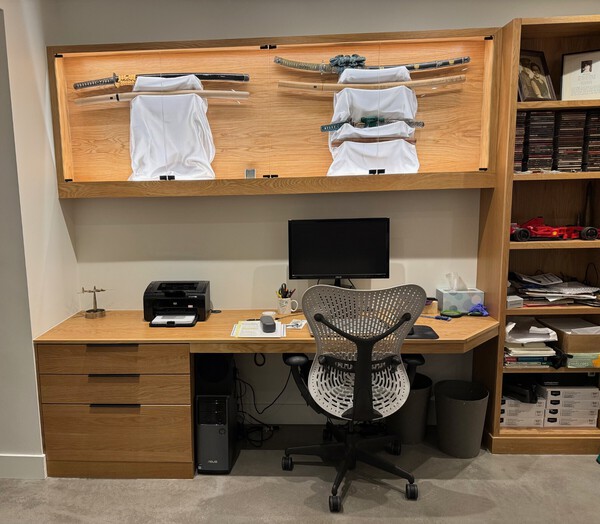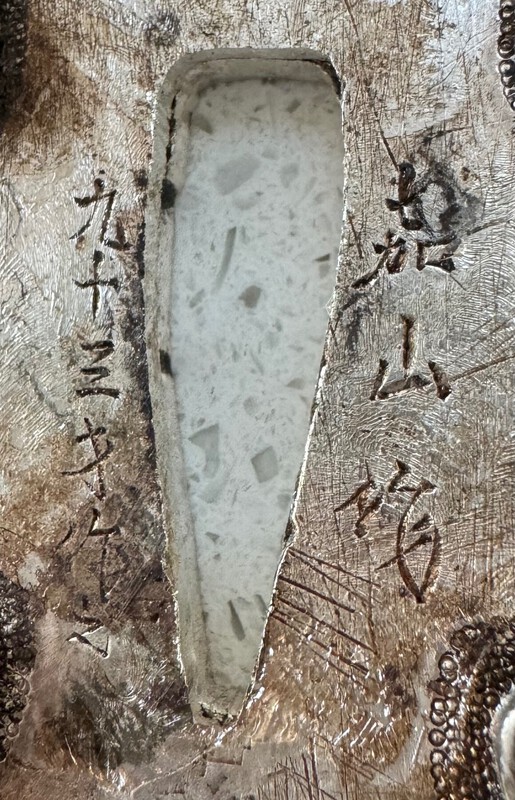
atm
Members-
Posts
126 -
Joined
-
Last visited
-
Days Won
1
Content Type
Profiles
Forums
Events
Store
Downloads
Gallery
Everything posted by atm
-
Masamune on Yahoo auctions Japan(Possibly)
atm replied to Ilovekatana's topic in Auctions and Online Sales or Sellers
This Juyo paper conundrum is super interesting. Here’s an example from Juyo 26, so it seems the changes to the tsuba ana and seal were a bit earlier than Juyo 28. -
That’s all very attractive, including interesting koshirae and the Tanobe sayagaki—congratulations!
-
Well done! Very satisfying to do it yourself.
-
Recommended books about Koshirae
atm replied to Avidmark's topic in General Nihonto Related Discussion
There is a more extensive color version also available from Lulu as an ebook or hardcover. It is called Koshirae Taikan. -
Thanks! It is on the top right. Definitely room for more!
-
I decided to build a display case for my small nihonto collection so that I could easily view them in my home office. To match the existing bookcases and desk, I built a box from 3/4-inch white oak plywood and 1x white oak for trim. The doors are tempered glass on minimalist pivot hinges. I also installed concealed LED lighting on the top and bottom to better highlight the contents. Finally, I cut out racks from MDF board that have satin covers to hide the unused spaces. It can accommodate 12 swords, so my collection has room to grow. I wanted to share because I’m really pleased with how it turned out. I am also curious if others here have unique ways they display their blades. If so, please share!
- 8 replies
-
- 15
-

-

-

-
Another reason to not force the blade past the point of resistance is that there may be something inside the saya. You may scratch the blade on whatever that is if you continue to push.
-
It is a tachi style tsuba. I don’t know what it is made of—it isn’t magnetic. Maybe pewter?
-
I am trying to read what is inscribed on a tsuba. On the left side I think I’ve got: ku (9) jyu (10) san (3) sen (thousand) ? kore (this) My novice brain is totally stumped on the right side. Any help is much appreciated.
-
Thank you all for the input and especially to @SteveM for generously correcting the rough translation. The sword is finally on its way to me, and I am very excited to study it in hand.
-
Mr. Tanobe completed the sayagaki. Here’s the translation I received (he had a lot to say about it!): Bingo Koku Ko Mihara Masaie Osuriage Mumei On the Nakago, there is an Hon'ami Koson's gold powder signature. But it is peeled off and illegible. The blade is wide and O-Kissaki, a magnificent figure. Shaped like a Enbun(1356-1361) and Jogi(1362-1368) era. The Itame Hada flows close to the Ha. There are beautiful Utsuri. Calm and elegant middle Suguha Hamon with Ko Nie. Boshi is Tsukiage shape and small round back. Yamato Den mixed with elements of Aoe. Komihara swordsmith masterpiece representing a master craftsman. This sword is very similar in appearance to the important artifact sword with the Keio date written on it. Blade length is 2 Shaku 3 Sun 7 Bu Han. Written by Mr. Tanobe in Feb 2024.
- 22 replies
-
- 14
-

-

-

-

-
I second Ray’s suggestion. I bought the ebook and it is a very worthwhile resource. And it appears that your smith is in it.
-
I’ve been using Singer machine oil: Link It is lightweight and spreads easily.
-
Impressive!
-
Thanks all for the thorough explanations and advice—it is all super helpful. I’ve confirmed that Mr. Tanobe will still write the sayagaki as Ko-Mihara Masaie despite the differing HBTHK appraisal, so I’ve asked for that to proceed without any modification to the kinpun mei. I knew the sword was a very good work; having him confirm that with his sayagaki is even better!
-
I need to clarify this with Aoi Art. If those are the only options, then I'm inclined to just have them send me the sword without the sayagaki. I don't think the time, effort, and risk of reappraisal at TH is worth it.
-
I recently purchased this katana from Aoi Art: https://sword-auction.com/en/product/20194/as20427-katana-yoshi-transmitted-as-aoe-school-青江nbthk-tokubetsu-hozon-token/ As stated, it has a partial gold mei and NBTHK appraised it as Aoe school. I asked Aoi Art to arrange for a Tanobe sayagaki. Aoi Art just relayed this to me from Mr. Tanobe after his examination: Mr. Tanobe judged this sword to be top-class Ko Mihara Masaie, not Aoe. He said that this sword looks really similar to the Juyo Bijutsu Ko Mihara Masaie. So he does not want to write the Sayagaki as Aoe. If you want to get his Sayagaki and new NBTHK Tokubetsu Hozon paper, we have to remove the gold signature completely and re-register the sword. It would take a lot of time (at least a year) and cost. There is no guarantee that it will be Ko Mihara Masaie because Mr. Tanobe and NBTHK have different views. In any case, Mr. Tanobe praised this sword as a rare good one. So, here's my dilemma. Do I ask that the sayagaki be done as Ko Mihara Masaie and have it different than the HBTHK appraisal (if Mr. Tanobe is willing to do it) or do I try to have it reappraised with the removed mei? If going through the time and effort of removing the mei and reappraisal, why not try for Juyo rather than reappraising Tokubetsu Hozon, which it already has? I lean toward the first option, as I greatly value Mr. Tanobe's opinion, it would not require messing with the sword, and it would get to me more quickly. But I am mindful that one day I (or my heirs) will need to sell this sword and am I better off taking the time now to hopefully (but no guarantee) align the appraisals or even shoot for Juyo? Any advice is greatly appreciated. Adam




